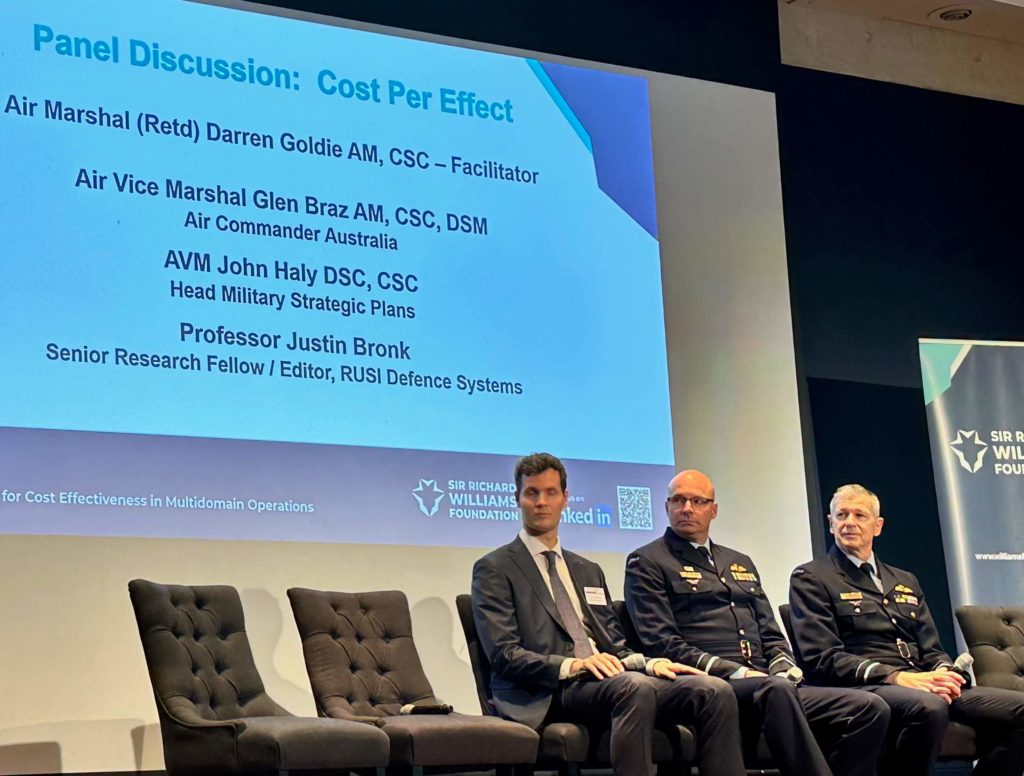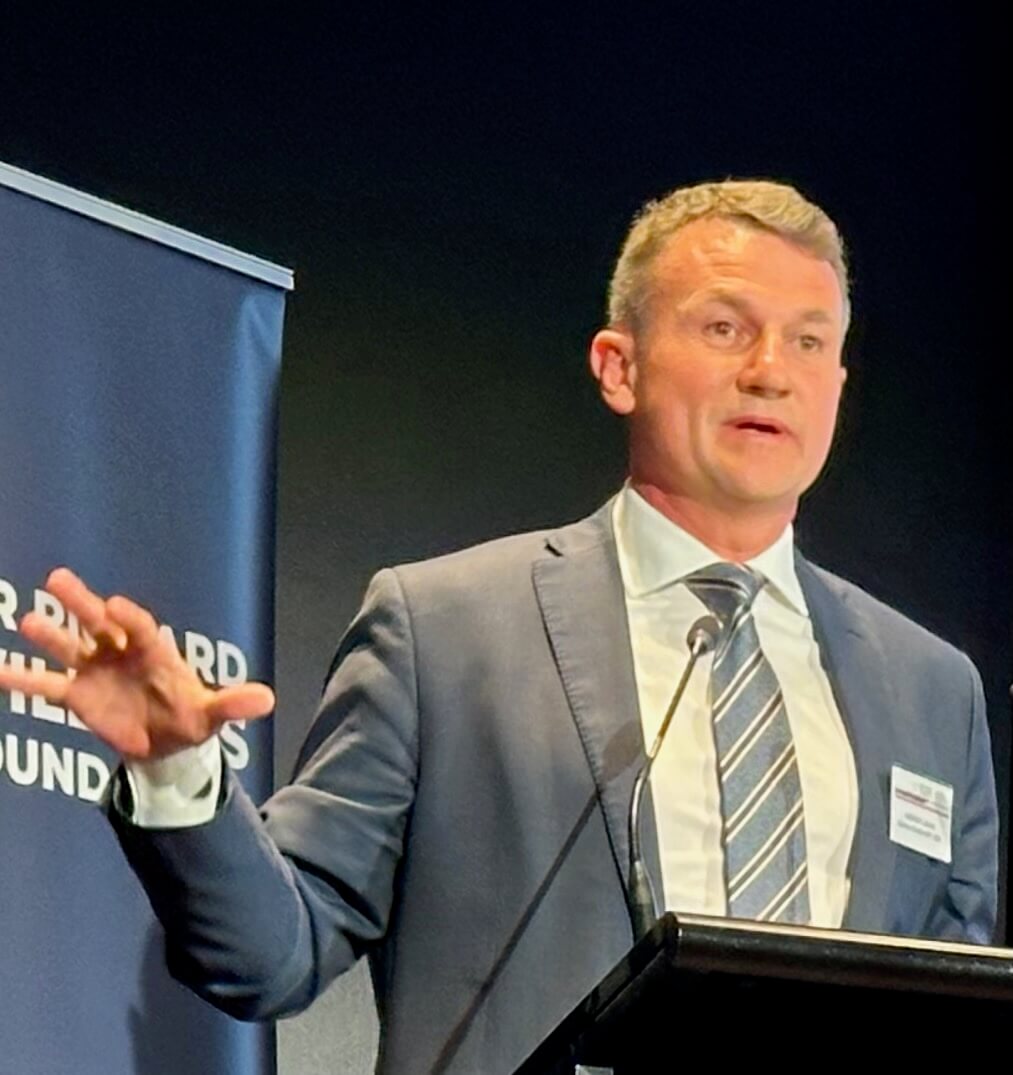Air Power and the Challenge of Shaping an Effective Ready Force Which Can Deliver Deterrence by Denial
The first of two panels held at the Sir Richard Williams Foundation seminar on May 22, 2025 was entitled a “Cost Per Effect” panel.
It was chaired by Air Marshal (Retd) Darren Goldie and the panelists were:
• Air Vice Marshal Glen Braz, Air Commander Australia.
• Professor Justin Bronk.
• Air Vice Marshal John Haly, Head Military Strategic Plans.
Air Marshal (Retd) Darren Goldie, Australia’s former Air Commander Australia and Australia’s inaugural National Cyber Security Coordinator within the Department of Home Affairs, opened with a reframing of military cost analysis. “Cost per effect,” he explained, “is far more complex than the old ‘cost per kill’ calculations.”
When Australia fires a maritime strike weapon over the horizon — of which the government has invested heavily —the true cost isn’t just the missile itself. It includes a proportional share of pilot training, the targeting enterprise, intelligence systems and everything else required to “render that ship useless.”
But the calculation becomes even more complex when considering deterrence effects. “We’re talking about a submarine program that exceeds $300 billion,” Goldie noted. “We will get submarines that ideally will never fire a weapon. The effect you seek there is deterrence.”
This distinction matters enormously for how Australia approaches defense spending. As Clausewitz observed, “the value of the object determines the measure of the sacrifices by which it will be purchased.” When the object is Australia’s sovereignty, the acceptable cost ceiling rises considerably.
Professor Justin Bronk highlighted the strategic shift of the past decade which can be described as the evolution from “deterrence by punishment” to “deterrence by denial.”
The old model — threatening massive retaliation after an invasion— no longer holds credibility against nuclear-armed great powers. “We’re not going to downtown Beijing. We’re not going to downtown Moscow. They’ll nuke us, let’s be clear,” Bronk stated bluntly.
Instead, the focus has shifted to preventing initial success. In Eastern Europe, this means stopping Russian advances before they can establish occupation zones. In the Indo-Pacific, it means preventing Chinese forces from gaining a lodgement in Taiwan — because “you’ll never kick them out if you do.”
This strategic shift has profound implications for capability development. Rather than building forces optimized for deep strikes against enemy homelands, the emphasis is on systems that can credibly deny an adversary’s initial objectives.

Air Vice Marshal Glen Braz emphasized that air power remains “fundamentally central to the national defense strategy.” Australia’s ability to project force quickly, deliver effects at long range, and provide options to government aren’t future aspirations — they’re current realities that need constant refinement.
“We need to find smarter, faster, more agile ways to deliver air power that makes a difference at scale, at range and at speed,” Braz explained.
“This isn’t just about buying platforms; it’s about building comprehensive capability through people, preparedness, and integrated systems.”
The challenge is particularly acute given Australia’s strategic geography. The National Defence Strategy calls for moving resources north but infrastructure development takes time. In the interim, forces must manage risk while building credible deterrent capabilities with existing assets.
Much of the conversation by the panel centered on people rather than platforms. Braz commands approximately 12,000 personnel across Air Force capabilities, and he’s acutely aware that technology alone doesn’t deliver effects.
“This is a human endeavor,” he emphasized. “These humans might use tools that are increasingly uncrewed or increasingly autonomous, but it’s a human endeavor.”
The Air Force is adapting by developing more flexible personnel who can operate across multiple roles while maintaining core technical proficiency. “We’re typically very specialist and very bespoke,” Braz noted, “but we need to broaden people’s aperture and use their intellect and talent in a myriad of ways.”
This isn’t about lowering standards — Air Force personnel remain “incredibly proficient” in their specialist roles. Instead, it’s about accepting calculated risk in how people are employed while building resilience through cross-training and adaptability.
The panel spent considerable time examining the seductive promise of cheap mass capabilities. Commercial drones costing $2,500 might seem like an obvious alternative to expensive military systems, but Bronk provided a reality check on the true costs of military-grade capabilities.
“You can have a small quadcopter that costs $2,500, but it doesn’t work in icing conditions, high winds, heavy rain, and doesn’t have night-capable cameras,” Bronk argued. Make it capable of all those things, “and it’s no longer $2,500 — it’s now $50,000, and you cannot have thousands of them.”
The challenge becomes even more complex for longer-range systems relevant to Indo-Pacific distances. A basic airframe for 1,000-kilometer range costs about $25,000, but adding encrypted data links ($70,000), AI-powered navigation, seekers, and warheads quickly pushes costs above $200,000 per unit.
This doesn’t mean cheap systems lack value — they can impose costs on adversaries by forcing them to expend expensive interceptors. But they complement rather than replace high-end capabilities.
Space capabilities are becoming more important as Australian and allied forces focus on effective ways to distribute force. As systems become more disaggregated and autonomous, they become increasingly dependent on space-based communications, navigation, and intelligence.
“The more you rely on one-way systems, including long-range strike munitions,” Bronk observed, “the more you’re likely to be reliant on that space situational awareness picture.”
Air Vice-Marshal John Haly, Head of Military Strategic Plans, emphasized the importance of “minimum viable capability” — systems that are “good enough on time” with the ability to be upgraded, rather than “exotic, wonderful and too late.”
The panel discussed as well how to characterize the threat in relation to a realistic approach which Australia can take to the threats in its region and beyond. As Haly noted, “we shouldn’t pretend that what we’re preparing for is Australia against a great power alone and unafraid. That’s not the case.”
Rather, Australian forces need to be prepared to prevail against the subset of threats likely to be directed against Australia as part of a broader conflict. This more realistic framing helps maintain confidence while acknowledging the serious nature of potential challenges.
The panel’s conclusions suggest several key principles for Australian defense planning:
• Integration over independence: Modern military effects require seamless coordination across domains, with space and cyber capabilities as critical enablers rather than separate domains.
• People as the foundation: Advanced technology amplifies human capability but doesn’t replace the need for skilled, adaptable personnel who can operate effectively under pressure.
• Strategic patience with tactical urgency: Major capability developments take time, but forces must maintain readiness and manage risk in the interim through innovation, training, and smart resource allocation.
• Alliance integration: Australia’s strategic challenges are best addressed through deeper integration with allies rather than pursuing independent solutions.
As the discussion concluded, Braz offered a note of measured optimism: “I am positive that our great people, well equipped and well trained, can do what the nation needs.”
In the context of a significant shift in the strategic framework and constrained resources, smart choices about capability development, force structure, and strategic priorities, a cost per effect framework provides a tool for making those choices
The challenge isn’t just building a military that can fight and win, but one that can deter conflict through credible capability and strategic clarity. In that mission, every dollar spent, and every person trained becomes part of a larger equation that ultimately determines whether Australia’s sovereignty can be preserved without having to test it in combat.
Success depends on smart resource allocation rather than simply buying cheap or expensive — it’s about understanding what effects are needed and the most efficient ways to achieve them.

